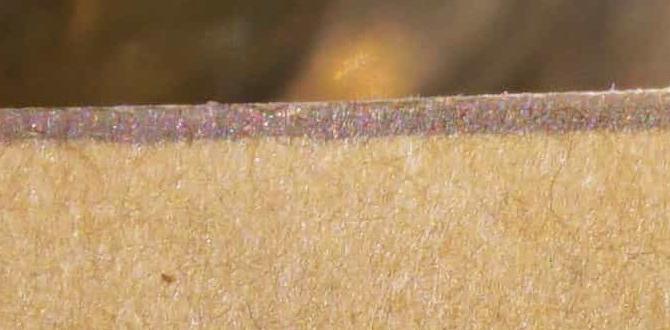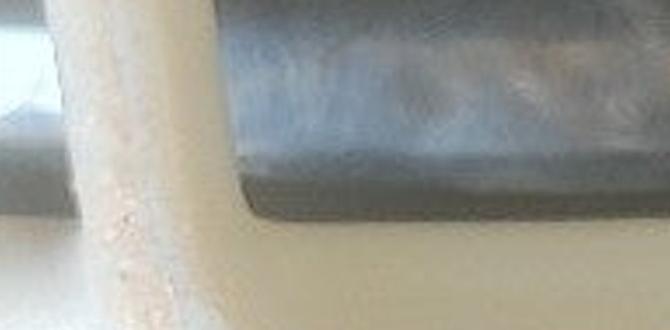Louisville Slugger Pro Leg Guards: The ultimate defense for any catcher, offering superior protection, comfort, and mobility to keep you in the game longer and performing at your best. Essential for serious players.
Stepping behind the plate is a big responsibility. You’re the field general, the anchor of the defense, and you’re going to take some hits. Protecting yourself is key, and that’s where your leg guards come in. For many players, especially those looking to step up their game, Louisville Slugger Pro Leg Guards are a top choice. But why are they so important, and what makes them stand out? Don’t worry if you’re new to this, we’ll break down everything you need to know about choosing and using the right leg guards. Get ready to feel more confident and secure behind the plate!
The Catcher’s Shield: Why Leg Guards are Non-Negotiable
Baseball, at its heart, is a game of inches and split-second decisions. Behind home plate, this intensity is amplified. A catcher’s job is demanding, requiring agility, quick reflexes, and an unwavering resolve. But it also comes with significant physical risks. Foul tips, wild pitches, collisions at home plate, and errant throws can all lead to painful injuries. This is precisely why high-quality catcher’s gear, especially leg guards, isn’t just an accessory – it’s a fundamental necessity.
Think of your leg guards as your personal armor. They are designed to absorb the impact of fastballs, protect your shins and knees from foul balls, and provide a stable base for you to receive pitches. Without them, the risks of serious injury skyrocket, potentially sidelining you for the season, or worse, impacting your long-term health. For any serious player, from youth leagues to the pros, investing in reliable leg protection is one of the smartest decisions you can make for your game and your body.
Why Louisville Slugger Pro Leg Guards?
Louisville Slugger is a name steeped in baseball history. For generations, players have trusted their bats, gloves, and equipment to perform at the highest level. Their Pro Leg Guards are no exception. They are engineered with the serious player in mind, blending cutting-edge technology with practical design to offer unparalleled protection and comfort.
What sets the Pro series apart? It’s a combination of:
- Advanced Protection: Featuring reinforced padding and strategically placed hard shells to absorb and deflect impact.
- Comfort and Fit: Designed for extended wear, with breathable materials and adjustable straps for a secure, personalized fit.
- Mobility: Despite their protective qualities, they are built to allow for a full range of motion, crucial for blocking pitches and making throws.
- Durability: Constructed with high-quality materials that can withstand the rigors of countless games and practices.
For players who demand the best and want to feel confident every time they crouch behind the dish, Louisville Slugger Pro Leg Guards offer a compelling solution.
Understanding the Anatomy of Louisville Slugger Pro Leg Guards
To truly appreciate the engineering behind Louisville Slugger’s Pro Leg Guards, it helps to understand the different components and how they work together to protect you.
Key Components:
- Shin Protection: This is the primary area of coverage. The shin guard typically consists of a thick, high-density foam or plastic shell designed to absorb the force of a direct impact from a pitched ball or a stray bat. The length and width are designed to cover the entire shin area, from just below the knee down to the top of the shoe.
- Knee Protection: A well-designed leg guard will have a robust knee cap or a strategically shaped pad that extends to protect the knee joint itself. This area is critical as knee injuries can be particularly debilitating. The knee protection often includes articulated joints to allow for bending and squatting without compromising coverage.
- Patella Protection: Some advanced models, including those in the Louisville Slugger Pro line, feature additional padding directly over the kneecap (patella). This adds an extra layer of defense against direct foul tip impacts.
- Ankle/Foot Protection: While the main focus is on the shin and knee, many leg guards extend down to offer some protection to the ankle area and the top of the foot. This might be through integrated padding or specially designed flaps that cover these vulnerable zones.
- Strapping System: The way the leg guards attach to your legs is crucial for comfort and security. Louisville Slugger Pro Leg Guards typically feature a series of adjustable, heavy-duty straps. These often include elastic elements to allow for some movement and flexing while maintaining a snug fit. Proper adjustment ensures the guards stay in place during intense play and don’t shift, which can lead to discomfort or exposure.
- Ventilation: Long games can get hot, and sweat can be a major source of discomfort. Good leg guards, especially those designed for professional play, incorporate ventilation systems. This can include breathable materials, perforations in the outer shell, and interior padding designed to wick away moisture and allow for airflow.
- Inner Lining: The material against your skin matters for comfort. Pro-level leg guards often feature a soft, padded, and sometimes moisture-wicking liner that feels good against your leg, even during long periods of wear.
Each of these elements is meticulously designed to work in harmony, providing a comprehensive protective system that doesn’t hinder a catcher’s ability to perform their duties effectively.
Choosing the Right Louisville Slugger Pro Leg Guards: Key Features to Look For
When you’re investing in gear like catcher’s leg guards, especially a pro-level model, you want to make sure you’re getting the best fit for your needs. Here’s what to consider:
Protection Level
Louisville Slugger offers different levels of protection. The “Pro” designation generally implies a higher standard of protection. Look for:
- Hard Shell Outer Layer: Made from durable plastics or composite materials engineered to deflect and absorb impact.
- Thick, High-Density Padding: Crucial for absorbing shock from foul tips and pitches. Density is key here – too soft and it won’t offer enough protection; too hard and it might be uncomfortable.
- Extended Coverage: Ensure the guards cover your shins, knees, and patella adequately. Check the dimensions to see if they align with your desired coverage area.
Comfort and Fit
Even the most protective gear is useless if it’s so uncomfortable you can’t focus or focus on adjusting it. Consider:
- Adjustable Straps: Multiple, wide, strong straps allow for a customized and secure fit. Velco or buckle systems are common.
- Ergonomic Design: Guards that move with your body, allowing you to squat, block, and throw without restriction. Articulated knee joints are a big plus.
- Weight: While robust protection often means some weight, pro-level guards are engineered to distribute this weight evenly and avoid being cumbersome.
- Ventilation: Look for features that promote airflow to keep your legs cooler and drier.
- Inner Padding: A comfortable, perhaps even removable, inner liner can make a big difference in long games.
Durability and Material Quality
You want gear that lasts. Louisville Slugger is known for quality, but it’s good to know what to look for:
- High-Quality Plastics: The outer shell should be robust and resistant to cracking.
- Durable Strapping: Ensure the straps are strong and the attachment points are reinforced.
- Reinforced Stitching: Where padding meets the shell, look for sturdy stitching that won’t fray or break.
Size and Length
This is arguably the most critical factor for effective protection and comfort. Leg guards are typically sized based on a combination of shin and knee length. Measure yourself or try them on if possible. General guidelines often exist, but individual body proportions vary.
For more information on general catcher’s gear sizing and protection standards, the National Federation of State High School Associations (NFHS) provides equipment guidelines.
Mastering the Fit: How to Properly Wear Your Louisville Slugger Pro Leg Guards
Getting the perfect fit for your Louisville Slugger Pro Leg Guards is crucial. It ensures maximum protection, comfort, and mobility. Here’s a step-by-step guide:
- Assess the Size: Before even putting them on, confirm you have the correct size. Generally, leg guards should cover the entire shin from just below the knee to the top of your shoe when you are in a catching stance.
- Position the Guards: Sit down in a crouched position, mimicking your stance behind the plate. Place the shin guards against your legs. The knee portion should sit comfortably over your kneecap, and the shin portion should extend down your leg. Ensure there’s no significant gap at the top (where your knee meets the guard) or at the bottom (where the guard meets your shin/shoe).
- Start with the Top Strap: Begin by fastening the uppermost strap, typically the one around the thigh. Tighten it enough to keep the guard somewhat in place but not so tight that it restricts blood flow or comfort.
- Secure the Knee Strap: Next, adjust the strap around the knee area. This strap is vital for keeping the knee protection properly aligned over your kneecap. It should be snug enough to prevent the guard from slipping, but again, avoid excessive tightness.
- Fasten the Shin Straps: Move down to the straps around your shin. These are critical for securing the lower portion of the guard. Make sure they are firm and even.
- Adjust the Ankle/Foot Strap (if applicable): Some models have a strap lower down. Adjust this for a secure fit around your ankle or the top of your foot.
- Perform the “Movement Test”: Once all straps are secured, stand up and squat down multiple times. Move your legs laterally and rotationally. The leg guards should stay firmly in place without shifting or pinching. You should be able to move freely without feeling restricted, and the protection should remain consistently positioned over your knee and shin.
- Check for “Digging In”: Make sure no part of the straps or the hard shell is digging uncomfortably into your legs. Adjust as needed.
- Final Check in Stance: Get back into your catching stance. Ensure the coverage is uniform and that there are no exposed areas of your shin or knee. The goal is full, uncompromised coverage.
Remember, the perfect fit might require a bit of trial and error, especially the first few times you wear them. Don’t hesitate to readjust the straps until you feel completely secure and comfortable.
Maintaining Your Louisville Slugger Pro Leg Guards for Longevity
Your Louisville Slugger Pro Leg Guards are an investment. To ensure they last through many seasons and provide consistent protection, proper maintenance is key. It’s not complicated, and a little effort goes a long way.
Cleaning
- Regular Wiping: After each use, wipe down the exterior of the leg guards with a damp cloth to remove dirt, mud, and sweat. This prevents grime from building up and becoming difficult to remove later.
- Deep Cleaning (as needed): For more embedded dirt or odors, you can use a mild soap (like dish soap) mixed with water. Use a soft brush or sponge for scrubbing. Be sure to rinse thoroughly with a clean, damp cloth to remove all soap residue.
- Interior Padding: The inner lining can be cleaned similarly. Gently wipe it down. For very persistent odors or sweat, some manufacturers offer removable padding that can be hand-washed in cool water and air-dried. Always check your gear’s specific care instructions.
- Avoid Harsh Chemicals: Never use aggressive cleaning agents, solvents, or abrasive cleaners, as these can damage the materials and compromise the protective integrity of the guards.
Drying
- Air Dry Only: This is critical. Always air dry your leg guards away from direct heat sources like radiators, ovens, or direct sunlight. Excessive heat can warp or degrade plastics and foams, weakening their protective capabilities.
- Ensure Complete Dryness: Before storing, make sure the leg guards are completely dry, both inside and out, to prevent mold or mildew growth.
Storage
- Cool, Dry Place: Store your leg guards in a clean, dry environment. A sports equipment bag or a dedicated shelf in a closet is ideal.
- Avoid Compaction: Do not store heavy objects on top of your leg guards, as this can lead to deformation and damage to the protective shells.
- Proper Positioning: If possible, store them to maintain their intended shape. Some players hang them up or keep them upright.
Inspection
- Pre- and Post-Game Checks: Before and after each game or practice, quickly inspect your leg guards.
- Look for Damage: Check for any cracks, deep scratches, or signs of wear on the hard shells.
- Inspect Straps and Buckles: Ensure all straps are intact, the Velcro or buckles are working properly, and there are no signs of fraying or tearing.
- Check Padding: Feel the padding for any signs of compression or degradation.
By following these simple maintenance steps, you can significantly extend the lifespan of your Louisville Slugger Pro Leg Guards and ensure they continue to offer the reliable protection you need behind the plate.
The Competitive Edge: How Pro Leg Guards Enhance Performance
It might seem counterintuitive, but high-quality catcher’s gear, including well-fitting leg guards, can actually enhance a player’s performance. It’s not just about avoiding injury; it’s about building confidence and enabling better execution.
Increased Confidence
Knowing you have superior protection allows you to play with more aggression and focus. You’re less likely to flinch on pitches in the dirt, less worried about foul tips, and more willing to block aggressively. This mental fortitude is invaluable on the field.
Improved Agility and Mobility
Louisville Slugger Pro Leg Guards are designed with an athlete’s movement in mind. Their ergonomic shaping and advanced strapping systems allow for a wider range of motion compared to bulkier, less technologically advanced gear. This means you can get out of your squat faster, block pitches more effectively, and move around the plate with greater freedom.
Better Pitch Framing
A stable base and confident receiver can lead to better pitch framing. When a catcher is comfortable and protected, they can focus on receiving the ball cleanly and presenting it to the umpire. The leg guards provide a solid foundation that helps absorb the impact of the pitch without excessive jarring, allowing for a smoother catch.
Endurance and Comfort
Long games can be draining, and uncomfortable gear only adds to the fatigue. The breathable materials, proper ventilation, and ergonomic design of Pro Leg Guards minimize discomfort from sweat and a poor fit. This allows you to maintain focus and energy throughout the entire game, rather than being distracted by chafing or pressure points.
Quick Recovery
The protective padding is designed not just to prevent injury, but also to absorb a significant amount of impact. This can lead to less soreness after blocking pitches or taking foul balls, helping you recover faster between innings and be ready for the next play.
Ultimately, when your gear is working for you, it allows you to focus entirely on your performance, making you a more effective and valuable player.
Beyond Louisville Slugger: Understanding Catcher’s Gear Standards
While Louisville Slugger Pro Leg Guards are an excellent choice, it’s worth understanding the broader standards and considerations in catcher’s gear. This knowledge can help you make informed decisions, whether you’re choosing Louisville Slugger or another reputable brand.
Certification and Standards
In youth leagues, especially, specific certifications might be required. For instance, Little League Baseball often has guidelines on acceptable equipment. While specific leg guard certifications aren’t as common as for helmets, the overall quality and design adhering to safety principles are paramount.
Materials Science in Gear
Modern catcher’s gear utilizes advanced materials. High-density foams are engineered to absorb force without adding excessive weight. Lightweight yet incredibly strong plastics and composites are used for the outer shells. Breathable, moisture-wicking fabrics are integrated into the padding and linings to enhance player comfort and hygiene. Understanding these material innovations helps explain why some gear offers superior protection and comfort.
Fit Based on Age and League
- Youth Leagues: Often focus on basic protection and compliance with league rules. Fit is paramount to ensure the gear stays secure on smaller athletes.
- High School/College: Performance and advanced protection become more critical. Players often seek gear that offers a balance of durability, protection, and mobility, like the Pro series.
- Professional: Professional players have the luxury of choosing the absolute highest level of protection and customization, often with input from their teams and specialized gear suppliers.
The Importance of a Full Catcher’s Set
Leg guards are just one piece of the puzzle. For complete safety, they should be used in conjunction with:



